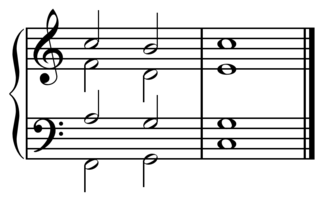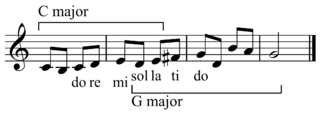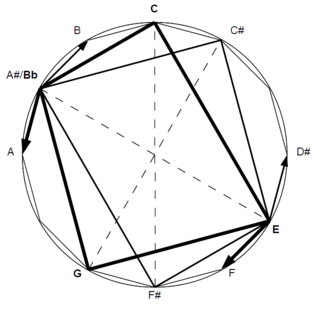In music, an eight-bar blues is a common blues chord progression. Music writers have described it as "the second most common blues form" being "common to folk, rock, and jazz forms of the blues". It is often notated in 4
4 or 12
8 time with eight bars to the verse.
The twelve-bar blues is one of the most prominent chord progressions in popular music. The blues progression has a distinctive form in lyrics, phrase, chord structure, and duration. In its basic form, it is predominantly based on the I, IV, and V chords of a key. Mastery of the blues and rhythm changes are "critical elements for building a jazz repertoire".

A three-chord song is a song whose music is built around three chords that are played in a certain sequence. A common type of three-chord song is the simple twelve-bar blues used in blues and rock and roll.
In music, an ostinato is a motif or phrase that persistently repeats in the same musical voice, frequently in the same pitch. Well-known ostinato-based pieces include classical compositions such as Ravel's Boléro and the Carol of the Bells, and popular songs such as Donna Summer and Giorgio Moroder's "I Feel Love" (1977), Henry Mancini's theme from Peter Gunn (1959), The Who's "Baba O'Riley" (1971), and The Verve's "Bitter Sweet Symphony" (1997).
In a musical composition, a chord progression or harmonic progression is a succession of chords. Chord progressions are the foundation of harmony in Western musical tradition from the common practice era of Classical music to the 21st century. Chord progressions are the foundation of popular music styles, traditional music, as well as genres such as blues and jazz. In these genres, chord progressions are the defining feature on which melody and rhythm are built.

In music, modulation is the change from one tonality to another. This may or may not be accompanied by a change in key signature. Modulations articulate or create the structure or form of many pieces, as well as add interest. Treatment of a chord as the tonic for less than a phrase is considered tonicization.
Modulation is the essential part of the art. Without it there is little music, for a piece derives its true beauty not from the large number of fixed modes which it embraces but rather from the subtle fabric of its modulation.
A secondary chord is an analytical label for a specific harmonic device that is prevalent in the tonal idiom of Western music beginning in the common practice period: the use of diatonic functions for tonicization.
In music, the submediant is the sixth degree of a diatonic scale. The submediant is named thus because it is halfway between the tonic and the subdominant or because its position below the tonic is symmetrical to that of the mediant above.
In music theory, a dominant seventh chord, or major minor seventh chord, is a seventh chord, composed of a root, major third, perfect fifth, and minor seventh. Thus it is a major triad together with a minor seventh, denoted by the letter name of the chord root and a superscript "7". In most cases, dominant seventh chord are built on the fifth degree of the major scale. An example is the dominant seventh chord built on G, written as G7, having pitches G–B–D–F:
In Classical music theory, a Neapolitan chord is a major chord built on the lowered (flatted) second (supertonic) scale degree. In Schenkerian analysis, it is known as a Phrygian II, since in minor scales the chord is built on the notes of the corresponding Phrygian mode.
Coltrane changes are a harmonic progression variation using substitute chords over common jazz chord progressions. These substitution patterns were first demonstrated by jazz musician John Coltrane on the albums Bags & Trane and Cannonball Adderley Quintet in Chicago. Coltrane continued his explorations on the 1960 album Giant Steps and expanded on the substitution cycle in his compositions "Giant Steps" and "Countdown", the latter of which is a reharmonized version of Eddie Vinson's "Tune Up". The Coltrane changes are a standard advanced harmonic substitution used in jazz improvisation.
Song structure is the arrangement of a song, and is a part of the songwriting process. It is typically sectional, which uses repeating forms in songs. Common forms include bar form, 32-bar form, verse–chorus form, ternary form, strophic form, and the 12-bar blues. Popular music songs traditionally use the same music for each verse or stanza of lyrics. Pop and traditional forms can be used even with songs that have structural differences in melodies. The most common format in modern popular music is introduction (intro), verse, pre-chorus, chorus, verse, pre-chorus, chorus, bridge, and chorus. In rock music styles, notably heavy metal music, there is usually one or more guitar solos in the song, often found after the middle chorus part. In pop music, there may be a guitar solo, or a solo performed with another instrument such as a synthesizer or a saxophone.

In music theory, chord substitution is the technique of using a chord in place of another in a progression of chords, or a chord progression. Much of the European classical repertoire and the vast majority of blues, jazz and rock music songs are based on chord progressions. "A chord substitution occurs when a chord is replaced by another that is made to function like the original. Usually substituted chords possess two pitches in common with the triad that they are replacing."

In music, a guitar chord is a set of notes played on a guitar. A chord's notes are often played simultaneously, but they can be played sequentially in an arpeggio. The implementation of guitar chords depends on the guitar tuning. Most guitars used in popular music have six strings with the "standard" tuning of the Spanish classical guitar, namely E–A–D–G–B–E' ; in standard tuning, the intervals present among adjacent strings are perfect fourths except for the major third (G,B). Standard tuning requires four chord-shapes for the major triads.

The Andalusian cadence is a term adopted from flamenco music for a chord progression comprising four chords descending stepwise – a iv–III–II–I progression with respect to the Phrygian mode or i–VII–VI–V progression with respect to the Aeolian mode (minor). It is otherwise known as the minor descending tetrachord. Traceable back to the Renaissance, its effective sonorities made it one of the most popular progressions in classical music.
In music, the axis system is a system of analysis originating in the work of Ernő Lendvai, which he developed in his analysis of the music of Béla Bartók.

In jazz, a turnaround is a passage at the end of a section which leads to the next section. This next section is most often the repetition of the previous section or the entire piece or song.
Excursions, Op. 20, is the first published solo piano piece by Samuel Barber. Barber himself explains:
These are ‘Excursions’ in small classical forms into regional American idioms. Their rhythmic characteristics, as well as their source in folk material and their scoring, reminiscent of local instruments are easily recognized.
In music, the dominant is the fifth scale degree of the diatonic scale. It is called the dominant because it is second in importance to the first scale degree, the tonic. In the movable do solfège system, the dominant note is sung as "So(l)".
In music, the V–IV–I turnaround, or blues turnaround, is one of several cadential patterns traditionally found in the twelve-bar blues, and commonly found in rock and roll.







